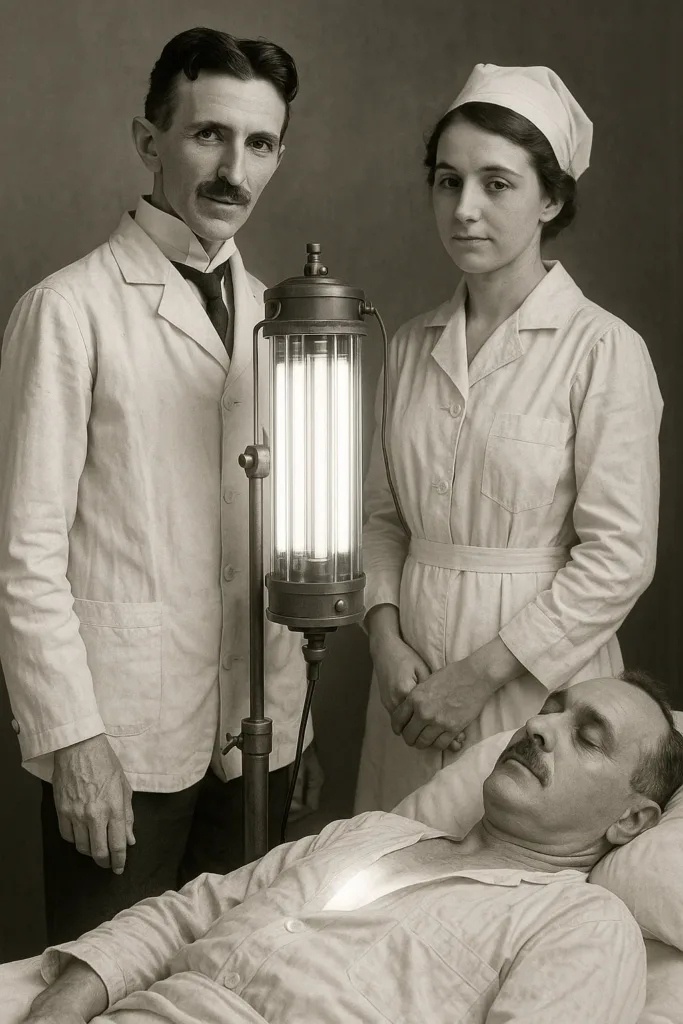Introduction: The Mysterious Experiments of a Great Inventor
Among the long list of inventions that marked Nikola Tesla’s career, one of the least known yet most controversial chapters is his experimentation with high-frequency currents and their potential use in treating various diseases. Although today this field lies at the intersection of science, alternative medicine, and the history of technology, it is worth remembering the man who, more than a century ago, intuitively sensed that electrical energy had a much broader application than simply lighting up cities.
High-Frequency Currents and Tesla as a Pioneer of Electrotherapy
As early as the late 19th century, Tesla began experimenting with high-frequency and high-voltage oscillations generated by his oscillators and Tesla coils. He claimed that such currents could pass through the human body without harmful effects—unlike the low-frequency currents known at the time, which caused muscle contractions and pain. He believed that these currents could stimulate the nervous system, improve circulation, act as antibacterial agents, and even help treat skin conditions.
At a lecture in St. Louis in 1893, Tesla demonstrated how high-voltage oscillations passed through his body without causing damage. His claim was that the body does not perceive these currents as dangerous because the high frequency does not cause electrolytic effects.
Violet Rays and the Beginning of Commercial Misuse
Based on Tesla’s ideas, the early 20th century saw the emergence of the first electrotherapy devices working on similar principles — so-called “Violet Ray” devices. These used gas tubes and high-voltage impulses to generate UV light, ozone, and electrical discharges. Marketed as miraculous cures for acne, inflammation, baldness, and even serious diseases like cancer — all without scientific validation — these devices quickly gained popularity in the U.S. and Europe, especially among alternative medicine practitioners and occultists, further discrediting this contribution of Tesla’s.
By the 1950s, the U.S. FDA had banned their sale due to false claims and potential health hazards.
Lack of Scientific Verification and the Reaction of the Scientific Community
Despite Tesla’s charisma and the enthusiasm he brought to his lectures and demonstrations, his experiments with high-frequency currents were never systematically studied under controlled conditions. No long-term studies were conducted on tissue effects, nor was a biochemical or molecular basis offered to support claims of curing diseases. The scientific community—by then increasingly favoring strict experimental methodology—began to turn away from him precisely because of such unsubstantiated assertions.
Soviet Interest and Continued Development of Electrotherapy
Interestingly, Tesla’s ideas about the therapeutic use of electromagnetic radiation found fertile ground—not in the West—but in the Soviet Union. Soviet scientists, particularly Aleksandr Gavrilov, conducted serious research during the 1950s and 1960s into magnetotherapy, microwave therapy, and low-intensity laser radiation. Some of these methods were used to treat sports injuries, arthritis, and even certain neurological and psychiatric disorders.
Unlike the American approach, which completely rejected Tesla’s ideas, the Soviets attempted to scientifically validate and clinically test them—with mixed results. To this day, Russia and China still employ certain electrotherapy techniques that are at least partially inspired by Tesla’s pioneering work.
Modern Echoes and Tesla’s Legacy
Today, electrotherapy exists as a legitimate field of physical medicine, including devices for transcutaneous electrical nerve stimulation (TENS), radiofrequency ablation for treating chronic pain and tumors, and pulsed electromagnetic fields for bone healing. These methods are based on modern biophysical principles and are clinically tested under strict regulatory conditions.
Nonetheless, it cannot be denied that Tesla was among the first to suggest that electricity and electromagnetic energy might have biological effects—long before science was able to provide a proper explanation for such phenomena.
Conclusion: Between Vision and Reality
Tesla’s experiments with high-frequency currents truly represent a pioneering attempt to extend technology beyond the realm of industry into that of human health. His ideas may have been ahead of their time—but were also insufficiently grounded in empiricism. In an era where science and pseudoscience often walk a fine line, it is worth remembering the man who, despite all controversies, opened the door to a field that still provokes equal parts interest, skepticism, and fascination.
Final Thought: A Visionary Who Saw the Future of Medicine
Nikola Tesla, as in many other areas, also foresaw trends in medicine that modern science would only begin to seriously consider decades later. While his methods were not always scientifically verified, his intuition about the connection between electricity and human health now gains a new dimension through the development of bioelectronics, regenerative medicine, and quantum biology. Tesla may have been alone in his visions, but through his courage and willingness to push boundaries, he laid the groundwork for questions that medicine is only just beginning to ask: can energy, properly directed, replace medicine?
Continuation of the Tesla Series
MilovanInnovation will continue its series on Nikola Tesla with a focus on his research into and application of resonance phenomena, further shedding light on how far ahead of his time he truly was — and how his ideas continue to inspire modern science and technology.


Leave a Reply